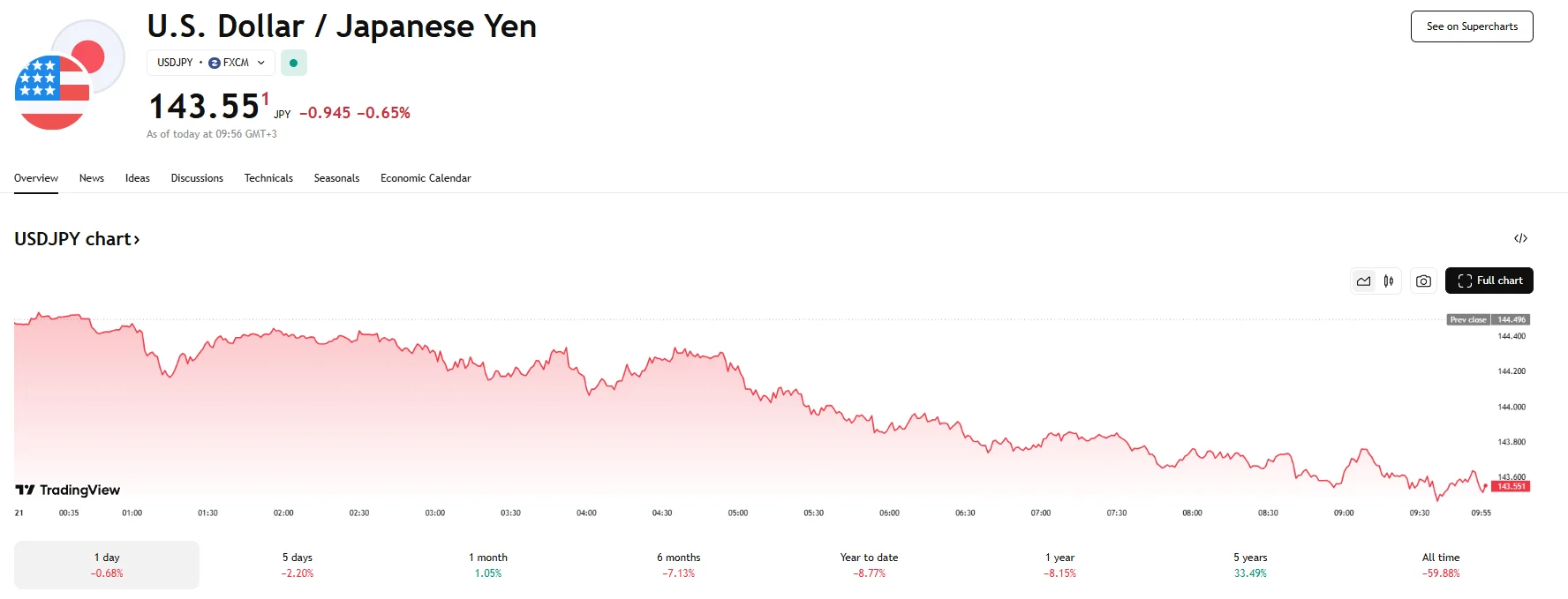Key Moments:The USD/JPY dropped 0.65% and below the 143.60 mark on Wednesday.Ongoing optimism for a US-Japan trade agreement and geopolitical concerns boosted safe-haven demand for the yen amid export
USD/JPY Drops to Two-Week Low Below 143.60 Despite Japan’s Trade Balance Contraction USD/JPY Drops to Two-Week Low Below 143.60 Despite Japan’s Trade Balance Contraction
Key Moments:
- The USD/JPY dropped 0.65% and below the 143.60 mark on Wednesday.
- Ongoing optimism for a US-Japan trade agreement and geopolitical concerns boosted safe-haven demand for the yen amid export growth decline.
- Bolstered expectations of Fed rate cuts and renewed US-China trade tensions weighed on the dollar.
Yen Continues Climb as Policy Expectations Diverge
The USD/JPY sank to its lowest level in two weeks on Wednesday, falling under the 143.60 threshold. This move followed an increase in investor confidence that the Bank of Japan will raise interest rates again in 2025, with concerns over persistent price increases in Japan driving this sentiment.

Optimism over a potential US-Japan trade agreement added another tailwind for the yen as Japanese Trade Minister Ryosei Akazawa and US Trade Representative Jamieson Greer are set to meet and discuss trade relations later this week. According to reports, Washington wants to accelerate the negotiation process.
Japanese Exports Wilt, Inflation Forecasts Hold Firm
Japan unexpectedly posted an April trade deficit of 115.8 billion yen, down from March’s 559.4 billion yen surplus, as weaker exports due to waning US demand offset resilient imports driven by wage hikes. However, this was not enough to reverse the USD/JPY pair’s losses today.
Moreover, despite the hiccup in trade figures, domestic inflation expectations remain firm. According to statements made by Deputy Governor Shinichi Uchida, core inflation is projected to gain momentum once again and stay close to the central bank’s 2% target. He reiterated that the Bank of Japan is ready to implement interest rate hikes if needed.
Global Tensions Affect Greenback
At the same time, the US dollar faced increasing selling pressure, influenced by rising expectations that the Federal Reserve will resort to interest rate cuts. These bets were amplified by unexpectedly soft US inflation readings and weaker monthly retail sales data last week. Investors have increasingly positioned for sluggish economic growth in the coming quarters. Federal Reserve officials like Mary Daly and Beth Hammack commented on how the impacts of Trump’s tariff policies on the US economy remained uncertain.
On the geopolitical front, mounting US-China trade tensions kept risk sentiment on edge following the Trump administration’s recent decision to warn companies about their usage of Ascend AI chips, which are manufactured by Huawei, as well as Chinese chips in general. This effort to exert pressure on Chinese chip exports was met with criticism by China’s Ministry of Commerce, which labeled the action as unilateral bullying and protectionism earlier this week. In addition, Wednesday saw Nvidia CEO Jensen Huang call the White House’s attempt to control exports of US chips to China “a failure.”






